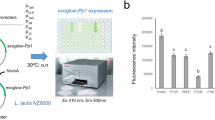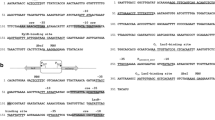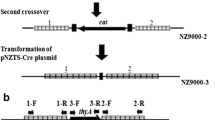Abstract
The genetic improvement of Lactococcus lactis is a matter of biotechnological interest in the food industry and in the pharmaceutical and medical fields. However, to construct a food-grade delivery system, both the presence of antibiotic markers or plasmid sequences should be avoided and the maintenance and expression of the cloned gene should be guaranteed. The objective of this work was to produce crossover mutants of L. lactis with a reporter gene under the control of an inducible promoter in order to evaluate the level of gene expression. We utilized a nuclease gene of Staphylococcus aureus as a reporter gene, P nisA as the nisin-inducible promoter, a non-essential gene involved in histidine biosynthesis of L. lactis as the site for homologous recombination, and pRV300 as a suicide vector for the genomic integration in L. lactis NZ9000. Single- and double-crossover mutants were identified by genotype and phenotype. Relative to episomal transformants of L. lactis, the level of expression of the heterologous protein after nisin induction was similar in the crossover mutants, suggesting that a single copy of the heterologous gene can be used to produce the protein of interest.




Similar content being viewed by others
References
Asseldonk M van, Rutten G, Oteman M, Siezen RJ, Vos WM de, Simons G (1990) Cloning of usp45, a gene encoding a secreted protein from Lactococcus lactis subs. lactis MG1363. Gene 95:155–160
Asseldonk M van, Vos WM de, Simons G (1993) Functional analysis of the Lactococcus lactis usp45 secretion signal in the secretion of a homologous proteinase and a heterologous α-amylase. Mol Gen Genet 240:428–434
Bron PA, Benchimol MG, Lambert J, Palumbo E, Deghorain M, Delcour J, Vos WM de, Kleerebezem M Hols P (2002) Use of the alr gene as a food-grade selection marker in lactic acid bacteria. Appl Environ Microbiol 68:5663–5670
Cuatrecasas P, Fuchs S, Anfisen CB (1967) Catalytic properties and specificity of the extracellular nuclease of Staphylococcus aureus. J Biol Chem 242:1541–1547
Davis A, Moore IB, Parker DS, Taniuchi H (1977) Nuclease B: a possible precursor of nuclease A, an extracellular nuclease of Staphylococcus aureus. J Biol Chem 252:6544–6553
Delorme C, Ehrlich SD, Renault P(1992) Histidine biosynthesis genes in Lactococcus lactis subsp. lactis. J Bacteriol 174:6571–6579
Dickley F, Nilsson D, Hansen EB, Johansen E (1995) Isolation of Lactococcus lactis nonsense suppressors and construction of a food-grade cloning vector. Mol Microbiol 15:839–847
Djordjevic GM, Klaenhammer TR (1998) Inducible gene expression systems in Lactococcus lactis. Mol Biotechnol 9:127–139
Eichenbaum Z, Federle MJ, Marra D, Vos WM de, Kuipers OP, Kleerebezem M, Scott JR (1998) Use of the lactococcal nisA promoter to regulate gene expression in gram-positive bacteria: comparison of induction level and promoter strength. Appl Environ Microbiol 64:2763–2769
Emond E, Lavallee R, Drolet G, Moineau S, LaPointe G (2001) Molecular characterization of a theta replication plasmid and its use for development of a two-component food-grade cloning system for Lactococcus lactis. Appl Environ Microbiol 67:1700–1709
Enouf V, Langella P, Commissaire J, Cohen J, Corthier G (2001) Bovine rotavirus nonstructural protein 4 produced by Lactococcus lactis is antigenic and immunogenic. Appl Environ Microbiol 67:1423–1428
Federal Register (1988) Nisin preparation: affirmation of GRAS status as a direct human food ingredient. Fed Regist 54:11247–11251
Gory L, Montel MC, Zagorec M (2001) Use of green fluorescent protein to monitor Lactobacillus sakei in fermented meat products. FEMS Microbiol Lett 194:127–133
Henrich B, Klein JR, Weber B, Delorme C, Renault P, Wegmann U (2002) Food-grade delivery system for controlled gene expression in Lactococcus lactis. Appl Environ Microbiol 68:5429–5436
Kleerebezem M, Beerthuyzen MM, Vaughan EE, Vos WM de, Kuipers OP (1997) Controlled gene expression systems for lactic acid bacteria: transferable nisin-inducible expression cassettes for Lactococcus, Leuconostoc, and Lactobacillus spp. Appl Environ Microbiol 63:4581–4584
Kovacevic S, Veal LE, Hsiung HM, Miller JR (1985) Secretion of staphylococcal nuclease by Bacillus subtilis. J Bacteriol 162:521–528
Kuipers OP, Beerthuyzen MM, Ruyter PG de, Luesink EJ, Vos WM de (1995) Autoregulation of nisin biosynthesis in Lactococcus lactis by signal transduction. J Biol Chem 270:27299–27304
Kuipers OP, Ruyter PG de, Kleerebezem M, Vos WM de (1997) Controlled overproduction of proteins by lactic acid bacteria. Trends Biotechnol 15:135–140
Langella P, Le Loir Y (1999) Heterologous protein secretion in Lactococcus lactis: a novel antigen delivery system. Braz J Med Biol Res 32:191–198
Langella P, Le Loir Y, Ehrlich SD, Gruss A (1993) Efficient plasmid mobilization by pIP501 in Lactococcus lactis subsp. lactis. J Bacteriol 175:5806–5813
Le Loir Y, Gruss A, Ehrlich SD, Langella P (1994) Direct screening of recombinants in Gram-positive bacteria using the secreted staphylococcal nuclease as a reporter. J Bacteriol 176:5135–5139
Le Loir Y, Gruss A, Ehrlich SD, Langella P (1998) A nine-residue synthetic propeptide enhances secretion efficiency of heterologous proteins in Lactococcus lactis. J Bacteriol 180:1895–1903
Le Loir Y, Nouaille S, Ribeiro L, Comissaire J, Cortheier G, Gilbert S, Chatel J, L’Haridon R, Gruss A, Langella P (2001) Sécrétion de protéines d’intérêt thérapeutique chez Lactococcus lactis. Lait 81:217–226
Leenhouts K, Buist G, Bolhuis A, Berge A ten, Kiel J, Mierau I, Dabrowska M, Venema G, Kok J (1996) A general system for generating unlabelled gene replacements in bacterial chromosomes. Mol Gen Genet 253:217–224
Maguin E, Prevost H, Ehrlich SD, Gruss A (1996) Efficient insertional mutagenesis in lactococci and other Gram-positive bacteria. J Bacteriol 178:931–935
Meer JR van der, Polman J, Beerthuyzen MM, Siezen RJ, Kuipers OP, Vos WM de (1993) Characterization of the Lactococcus lactis nisin A operon genes nisP, encoding a subtilisin-like serine protease involved in precursor processing, and nisR, encoding a regulatory protein involved in nisin biosynthesis. J Bacteriol 175:2578–2588
Piard JC, Hautefort I, Fischetti VA, Ehrlich SD, Fons M, Gruss A (1997) Cell-wall anchoring of the Streptococcus pyogenes M6 protein in various lactic acid bacteria. J Bacteriol 179:3068–3072
Platteeuw C, Alen-Boerrigter I van, Shalkwijk S van, Vos WM de (1996) Food-grade cloning and expression system for Lactococcus lactis. Appl Environ Microbiol 62:1008–1013
Poquet I, Ehrlich SD, Gruss A (1997) An export-specific reporter designed for gram-positive bacteria: application to Lactococcus lactis. J Bacteriol 180:1904–1912
Ravn P, Arnay J, Madsen MS, Vrang A, Israelsen H (2003) Optimization of signal peptide SP310 for heterologous protein production in Lactococcus lactis. Microbiology 149:2193–2201
Ribeiro LA, Azevedo V, Le Loir Y, Oliveira SC, Dieye Y, Piard JC, Gruss A, Langella P (2002) Production and targeting of the Brucella abortus antigen L7/L12 in Lactococcus lactis: a first step towards food-grade live vaccines against brucellosis. Appl Environ Microbiol 68:910–916
Rooijen RJ van, Gasson MJ, Vos WM de (1992) Characterization of the Lactococcus lactis lactose operon promoter: contribution of flanking sequences and LacR repressor to promoter activity. J Bacteriol 174:2273–2280
Ruiter PG de, Kuipers OP, Vos WM de (1996) Controlled gene expression systems for Lactococcus lactis with the food-grade inducer nisin. Appl Environ Microbiol 62:3662–3667
Sambrook J, Fritish EF, Maniatis T (2001) Molecular cloning. A laboratory manual. Cold Spring Harbor Laboratory, Cold Spring Harbor, N.Y.
Shortle D (1983) A genetic system for analysis of staphylococcal nuclease. Gene 22:181–189
Simon D, Chopin A (1988) Construction of a vector plasmid family and its use for molecular cloning in Streptococcus lactis. Biochemie 70:559–566
Soresen KI, Larsen R, Kibenich A, Junge MP, Johansen E (2000) A food-grade cloning system for industrial strains of Lactococcus lactis. Appl Environ Microbiol 66:1253–1258
Steidler L, Robinson K, Chamberlain L, Schofield KM, Remaut E, Le Page RW, Wells JM (1998) Mucosal delivery of murine interleukin-2 (IL-2) and IL-6 by recombinant strains of Lactococcus lactis coexpressing antigen and cytokine. Infect Immun 66:3183–3189
Takala TM, Saris PE (2002) A food-grade cloning vector for lactic acid bacteria based on the nisin immunity gene nisI. Appl Microbiol Biotechnol 59:467–471
Vos WM de (1999a) Safe and sustainable systems for food-grade fermentations by genetically modified lactic acid bacteria. Int Dairy J 9:3–10
Vos WM de (1999b) Gene expression systems for lactic acid bacteria. Curr Opin Microbiol 2:289–295
Vos WM de, Simons GFM (1994) Gene cloning and expression in lactococci. In: Gasson MJ, Vos WM de (eds) Genetics and biotechnology of lactic acid bacteria. Chapman and Hall, London, pp 52–105
Vossen JM van der, Lelie D van der, Venema G (1987) Isolation and characterization of Streptococcus cremoris Wg2-specific promoters. Appl Environ Microbiol 53:2452–2457
Acknowledgements
This work was supported by the Institut National de la Recherche Agronomique, France, CNPq, Brazil and the Universidade Católica de Brasília, Brazil.
Author information
Authors and Affiliations
Corresponding author
Rights and permissions
About this article
Cite this article
Simões-Barbosa, A., Abreu, H., Silva Neto, A. et al. A food-grade delivery system for Lactococcus lactis and evaluation of inducible gene expression. Appl Microbiol Biotechnol 65, 61–67 (2004). https://doi.org/10.1007/s00253-004-1555-0
Received:
Revised:
Accepted:
Published:
Issue Date:
DOI: https://doi.org/10.1007/s00253-004-1555-0




